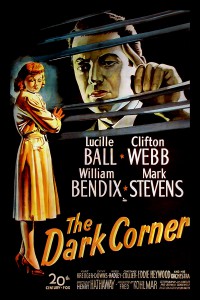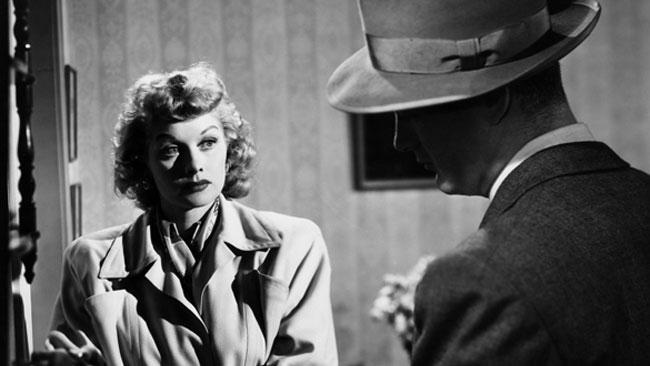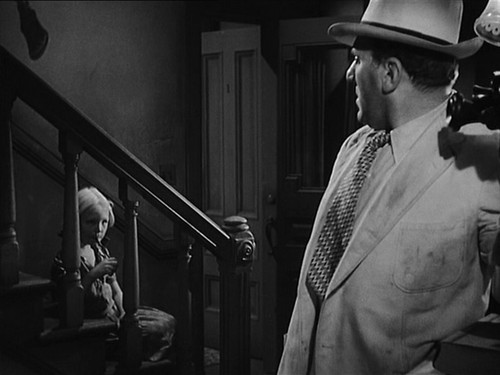Written by Bernard C. Schoenfeld and Jay Dratler
Directed by Henry Hathaway
USA, 1946
Bradford Galt (Mark Stevens) is a private investigator with a modest office in Manhattan. His only help is in the shape of his trusty and charismatic receptionist Kathleen (Lucille Ball). One evening after a day’s work, Brad convinces Kathleen to spend the evening with him, not too difficult a feat given that she fancies her employer. When perusing the games at a carnival, it comes to their attention that a tough-looking man dressed in a shiny white suit (William Bendix) is tailing them. One thing leads to another (including an attempt on Brad’s life) until the private dick gets his tail to fess up his employer. It turns out Brad’s former partner and now lawyer Tony Jardine (Kurt Kreuger) is keeping tabs on him. What neither Brad nor Tony know, however, is that one of New York’s leading art curators, Hardy Cathart (Clifton Webb) is playing the old foes against one another to protect something very precious to him.
There are movies where everything comes together via great direction, acting, cinematography, set design and a tight script to produce a perfect movie. The ingredients are all there for the taking and the right people come around to use each and produce the best movie possible. Then there are cases that end up being plenty of fun, overcoming a bevy of missteps in the process. These films have flaws, which are at times difficult to watch, but somehow by the time they conclude, one cannot deny their coolness. Henry Hathaway’s The Dark Corner falls in the latter category. The logic behind several character motivations must be deduced because the script is never entirely certain how to fit the pieces together and the direction is hit-and-miss, yet there are so many amusing elements to Dark Corner that it basically earns a recommendation regardless.
The set-up is legitimately competent, with a compelling mystery presented to Brad and Kathleen upon the appearance of their curiously dressed follower. Why the man is closely following their every move and how could he think such an ostentatious get-up was a smart idea for a job requiring inconspicuous behaviour is puzzling. Equally curious is why Brad’s former friend turned enemy would want to have updates on his whereabouts and activities. The first half hour or so does an admirable job planting the seeds of danger and mystery. The problems begin rearing their ugly heads when more pawns are introduced, namely Tony, Hardy, and the latter’s much younger wife Mari (Cathy Downs). The film takes the long, long way around to explain that it is Hardy, with the help of the hired goon dressed in white, who is pulling the strings, pitting Brad and Tony in a feud for his own benefit.
Strangely, it is never made explicitly clear why Hardy is performing these Machiavellian machinations. The film reveals that Tony and Mari are having an affair, a revelation that irks Hardy greatly. That makes enough sense and the viewer easily understands why the curator wants Tony out of the picture. Questions remains, however. First, what does Brad have to do with Mari’s infidelity? Second, Hardy learns of his wife’s promiscuity long after he has made Tony and Brad come to blows, so why was he doing so in the first place? One can extrapolate that Hardy had for some time viewed Tony as a rival to his wife’s affections and dug into the opposite’s past, learned of his falling out with Brad back in San Francisco and opted to use that to plant the seed’s of Tony’s destruction. It is logical on some levels but that is only by deduction based on limited information as presented by the movie. The script never really clarifies the matter.
As previously stated, the direction is a mixed bag through and through. Some scenes have a flat, lifeless tone about them, unaided by the limited set design for various locations, including Brad’s office, which looks as if it had been furnished in little time and with a limited budget. Moments will go by when it seems as though director Hathaway provided the actors little no direction, leaving them to improvise for a few seconds. Such instances are fleeting but still noticeably awkward.
Funnily enough, these matters are not enough to doom The Dark Corner to failure. Despite its shortcomings, the filmmakers still muster a charming enthusiasm for the project that can be felt, making the movies light and fun. Hathaway is quite evidently influenced by the chiaroscuro lighting that helped earn the dramas of this period their reputation, what with a handful of visually rich, lustful scenes that stand proudly alongside some of the best noirs. Set design aside, credit need go to cinematographer Joseph Macdonald for making the most mundanely built sets look as sleek and sexy as something out of The Big Heat. The famous play of light and shadow that so many people immediately allude to when describing noir is on full display on numerous occasions in The Dark Corner. And why not? If the sets are so cheap-looking on their own, spruce them up with the help of a talented cinematographer. Even with this flaws, the movies ends up being a fairly handsome piece of work.
The real fun lies with the leads, specifically Lucille Ball, Mark Stevens and Clifton Webb, the latter of whom some might recognize from Otto Preminger’s Laura. First and foremost, in case anyone has any lingering doubts, let it be known that Lucille Ball is amazingly talented. Easy on the eyes, she knows how to deliver witty lines that seduce just as they can produce belly laughs. She can play the concerned lover on instant and a determined go-getter the next. Ball brings undeniable energy to the role of Kathleen, but a controlled and focused energy, not the annoyingly many type. For anyone looking for an introduction to the Lucille Ball experience, The Dark Corner is not a bad place to start. Stevens cannot bring the same gusto but his role doesn’t demand it. He fits the mold of the hard-nosed, cynical, hard-drinking type. He needs to be pushed by Kathleen, who functions as his spirit and backbone. Finally, Webb plays Hardy Cathart, a role similar to the one he played in Laura. An aristocratic, high-society fellow with a wife many years his junior, Hardy is the sort of villain who always stabs in the back and usually gets someone else to do the stabbing for him if it can be helped. Webb always excels at playing this sort of self-righteous prude. The only issue plaguing his scenes is the uncomfortably stiff performance from Cathy Downs who plays Mrs. Cathart. She is, unfortunately, as lifeless as a board of plywood and when acting opposite of a great like Webb, it looks even worse.
The Dark Corner is far from perfect. Truth be told, Hathaway’s picture is as flawed as can be while still possessing enough fighting spirit to keep it afloat. There is a fair amount of fun to be had amidst the flotsam and jetsam and sometimes that’s enough to leave a smile on one’s face.
— Edgar Chaput




